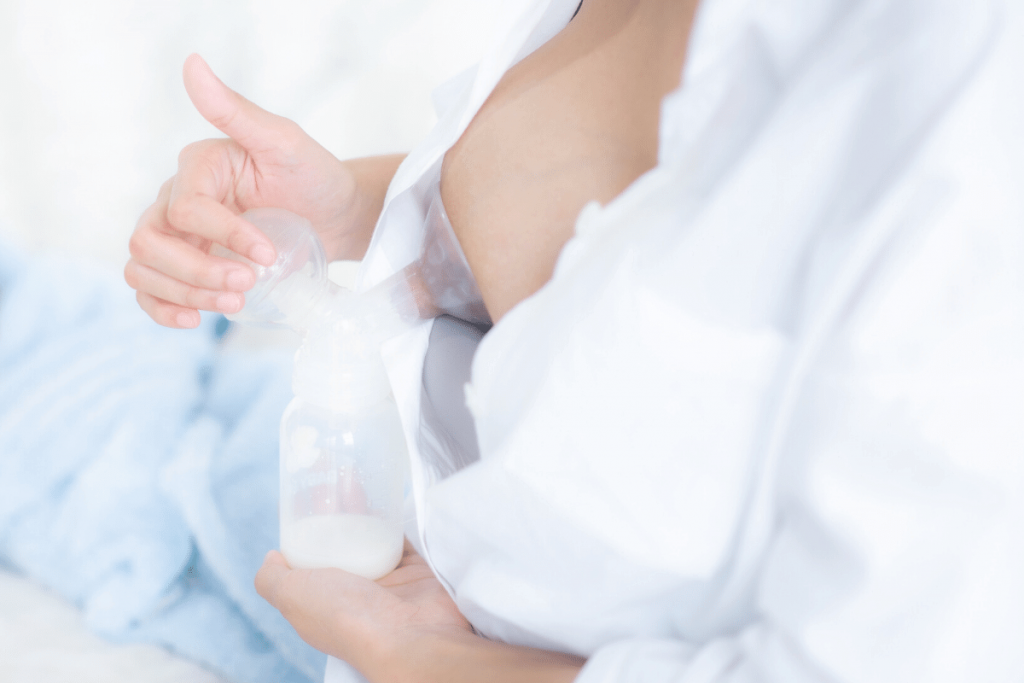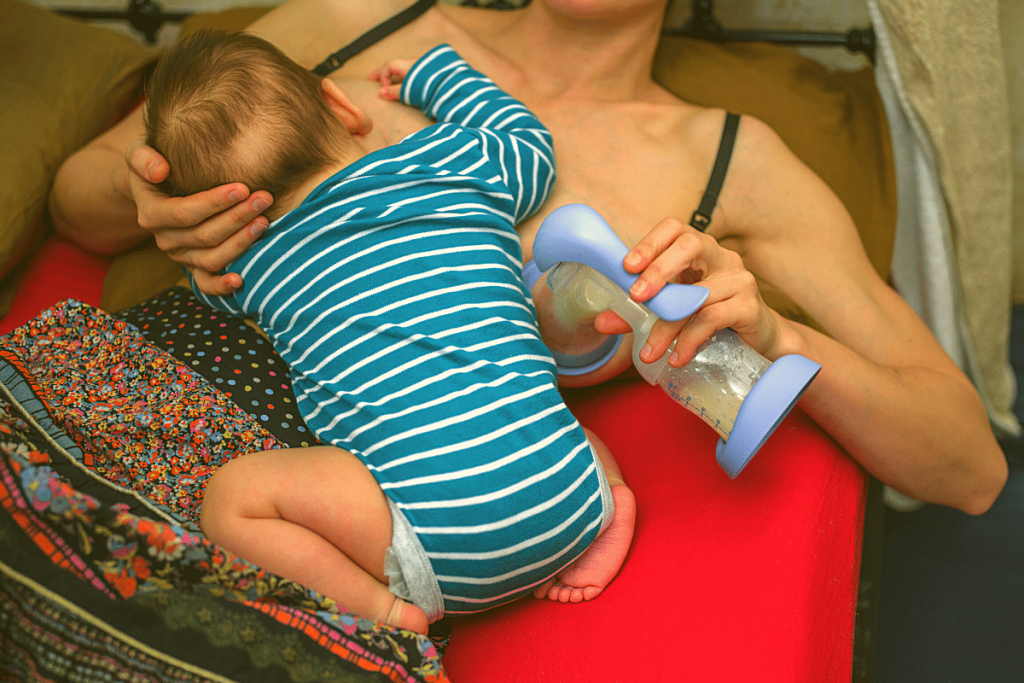Today I would like to introduce Kealy, a Registered Nurse, Certified Lactation Counsellor, and most importantly, a mum. At Little Bear Care, she offers offers one-on-one lactation consultations, breastfeeding classes, and shares her knowledge to equip and empower mums. Kealy will be sharing her tips on how to pump and breastfeed at the same time.

Breastfeeding mamas often wonder how to pump and breastfeed at the same time. They might want to pump on one side while baby nurses on the other. Or maybe they wonder how to pump between feedings, and if they’ll have enough milk.
Good news!
It’s a common question, and lots of mums do it. Let’s take a look at how!
Are you looking for a breast pump? The Spectra S1 and S2 are popular amongst mums who pump and breastfeed.
Table of Contents
Do You Have Enough Milk?
Mums often wonder if they’ll have enough milk to pump and breastfeed at the same time. It makes sense to worry, but think about this.
Mums with twins can successfully breastfeed both twins at the same time!
The reason for this is your milk supply depends on demand. If you pump or breastfeed more, you will make more. If you decide to pump after, during, or between feedings your body will respond by increasing breast milk production.
Different Ways To Breastfeed

Every mum and baby breastfeeding relationship is different. Some mums choose to breastfeed from one breast per feeding and do the other breast at the next feeding. Other mums feed from both breasts each time. It’s totally up to each mum and baby!
When your baby breastfeeds, sometimes the breast on the opposite side lets out milk (called a let-down). The milk will just go into a bra or nursing pad, but some mums want to catch it so they can store it.
Breast Pumps Aren’t As Effective As Babies

An important thing to consider when pumping is what you see coming from the pump. Many mums decide to start pumping and are shocked at how little milk comes out! Some mums notice hardly any milk coming out at all.
That’s because babies are FAR more efficient than breast pumps!
When adding a pumping session to your breastfeeding routine, remember that demand increases supply. Even if you don’t see any milk coming out, your body is getting the message to produce more milk. It will catch up and soon you should start to see more milk each time you pump.
Reasons To Pump And Breastfeed

There are a whole host of reasons a mum might want to pump and breastfeed.
1. Catch the letdown
As mentioned earlier, they may want to catch the letdown on the opposite side while nursing. It’s a smart thing to do because the milk is coming out anyway – why not make use of it?
2. Return to work
Some mums start working after their maternity leave and want to have a supply built up for when they’re away.
3. Comfort feeding in public
Other mums just feel more comfortable bottle feeding out in public rather than breastfeeding. Having stored breast milk gives you bottle feeding options!
4. Increasing milk supply
Increasing milk supply is another reason mums start pumping. Many mums worry their supply is low, and additional pumping is a great option for increasing it. Having a stash of breast milk stored offers peace of mind for when a mum worries her supply is inadequate.
5. Give breasts a break!
Another reason to add pumping to the routine is to give your breasts a break! Sore breasts are common in the first days of breastfeeding. Some babies need a little time and patience to get a good breastfeeding latch down. Mums may find it helpful to pump one breast while feeding baby with the other, to give their nipples a break!
How to Pump and Breastfeed
Wait Until Your Supply Is Established
It’s best to wait until your breast milk supply is established before pumping. Pumping too early can cause oversupply and engorgement. Oversupply can lead to clogged ducts and mastitis. Not to mention, it’s extremely uncomfortable!
The recommendation is to wait until 6 weeks before you start pumping. If you can’t wait that long, just try and go as long as you can breastfeeding to establish a normal supply.
If you can’t wait 6 weeks to start pumping, don’t worry! There are all sorts of reasons mums add in pumping sooner. Mummies with NICU babies have to pump if their baby gets breast milk. Maybe you have to return to work earlier than 6 weeks or you want to build up your milk supply before then. Whatever the reason, it’s okay!
Feed From One Side While Pumping The Other

You can breastfeed while pumping if you have a single breast pump or passive pump. Some electric breast pumps are meant to pump from only one breast, and some double breast pumps give you that option. There are also hand-held breast pumps that work on just one side, but you’ll have to squeeze it for each pump.
One of the best options for this is a Haakaa breast pump, or other passive pump. Passive pumps work by attaching to your breast with vacuum suction. They pull the milk out and catch a let down on the opposite side!
It can be hard to juggle breastfeeding your baby and getting your pump set up on the other side, but with practice many mums are great at it! Try getting everything set up beforehand so you’re ready to go at the next feeding time.
If you decide to breastfeed and pump simultaneously, switch breasts each time! A baby is more efficient than a breast pump, so switching each time ensures that you’ll have a more even milk supply in each breast.
Pump After Or Between Feedings

Some mums decide to pump between normal breastfeeding times. You can pump right after feeding your baby or wait 30 minutes to 1 hour. Try not to wait too long though. Pumping too close to the next feeding can frustrate your baby because you’ll have a slower let-down. In other words, it will take more work to get the milk out.
Leave at least 1 hour from the time you pump until the next feeding. That will give your breasts enough time to build up milk and give your baby enough to breastfeed.
If you pump right after breastfeeding your baby, milk may not come out. Your baby is an efficient nurser and mums worry that their supply isn’t adequate. Just because the pump doesn’t produce any milk doesn’t mean you don’t have any left. If your baby were to start breastfeeding again, they would be able to express breast milk much better! In this case, just pump for 5-10 minutes after feeding. Even if you don’t produce any milk, the stimulation is telling your body to increase your milk supply. In a day or two, you will probably start to see milk during the times you pump after feeding.
Start Slow
Start slow mummies! Especially if you are starting before your baby’s 6 weeks old – you don’t want to go too crazy with the pumping. It can take a few days for your supply to catch up to the signals it’s receiving.
Going slow helps to prevent engorgement and oversupply. Try adding one pumping session each day and see how your milk supply responds.
If you have any questions or concerns about your milk supply, don’t be afraid to ask for help! Hospitals often offer breastfeeding classes or have lactation consultants. You may also be close to a local breastfeeding support group. Pumping and breastfeeding at the same time is common for mums to do, and it can help to have a little support along the way.
Author Bio
Kealy is a Registered Nurse, Certified Lactation Counsellor, and most importantly a mummy! Her own breastfeeding struggles gave her a passion to help mums throughout their breastfeeding journey. She offers one-on-one lactation consultations, breastfeeding classes, and shares her knowledge to equip and empower mums. If you’re interested in talking with her or taking one of her breastfeeding classes, visit Little Bear Care.
